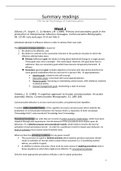Summary readings
The Social Psychology of Communicati on
Week 1
Dillard, J.P., Segrin, C., & Harden, J.M. (1989). Primary and secondary goals in the
production of interpersonal influence messages. Communication Monographs,
56, 19-38. (only study pages 19-24 and Table 2)
Individuals attempt to influence others in order to achieve their own ends.
The persuasive strategy selection is based on
1. the desire to be effective, and
2. the desire to conform to the constraints inherent in the particular situation in which the
influence attempt takes place.
Primary (influence) goal: the desire to bring about behavioral change in a target person.
These goals may vary in strength – the central goal. However, this goal alone has no
substance, they are secondary goals which have become temporarily dominant.
efficacy.
Secondary (general) goal: includes objectives of several sorts that derive directly from
more general motivations that are recurrent in a person’s life. appropriateness.
Identity goals: related to the self-concept.
Interaction goals: concerned with social appropriateness.
Resource goals: increasing or maintaining valued assets, with relational, material,
or physical assets.
Arousal management goals: maintaining a state of arousal.
Greene, J. O. (1984). A cognitive approach to human communication: An action
assembly theory. Communication Monographs, 51, 289–306.
Communicative behavior is at once novel and creative, yet patterned and repetitive.
A model (action assembly theory) of the cognitive structures and processes which underlie the
production of communicative behaviors: the human mind is a repository of both conceptual
(“knowledge that”) and procedural (“knowledge how”) knowledge.
Procedural knowledge has units that are records of action-outcome relationships, which have been
required through past experiences. Not all elements of the procedural store impact upon all
behaviors a selection process over procedural records, which holds to involve the level of
activation of each procedural record – in order for a particular record to impact upon behavior, its
level of activation must exceed some threshold value.
What are then the activating conditions for any given record?
The occurrence of a goal or desired outcome which matches previous outcomes should
result in activation of records which contain these outcomes (i.e. if something worked
before, you will do it again).
In addition to desire outcomes, there must be some means of applying procedures only in
those situations in which they might prove effective conceptual knowledge.
Only the most appropriate procedures will play a role in output production.
1
, So, the content of any representational level at any moment is due to
1. constraints imposed by higher-level representations;
2. existing procedural records at that level of abstraction; and
3. activating conditions relevant to that level of abstraction.
Week 2
Elbert, S.P., & Dijkstra, A. (2014). An experimental test of the relationship
between voice intonation and persuasion in the domain of health. Psychology &
Health, 29, 1014–1031.
Characteristics of voice, such as speech rate, voice pitch, fluency, intensity and intonation, have been
found to be related to persuasion in varying degrees.
Think of help-desk employees or telephone sales persons who aim to persuade the recipient
by voice.
Aim of the study: assess how intonation may influence respondents’ behavioral intention when
presented with an auditory persuasive health message.
Intonation: the variation in pitch while speaking. It is an indicator of speech melody.
It provides information related to the grammatical and information structure of a sentence
by
(I) giving meaning to a sentence, and
(II) emphasizing particular words or ideas.
Thereby, it supports the receiver in the interpretation of utterances.
It is used to transfer information regarding attitudes and emotions of the speaker.
Studies show that there is an optimum of intonation in persuasion: to a certain extent a positive
relationship between intonation and persuasion can be found, but an even greater rate of intonation
(e.g. too high intonation levels) may be associated with less persuasion and less influence.
This study tests this relation in the domain of health in an experimental design.
Study 1
Intonation was experimentally manipulated into speech with a (I) low level of intonation, (II) medium
level of intonation, and (III) high level of intonation.
With people who perceive their health as good:
Hypothesis 1a: a moderate level of intonation will lead to more persuasion compared to a
low level of intonation.
Hypothesis 1b: a high level of intonation will lead to less persuasion compared to a moderate
level of intonation.
With people who perceive their health as poor:
Hypothesis: level of intonation does not lead to differences in persuasion.
Dependent variable: the intention to increase fruit and vegetable intake.
Independent variable: intonation.
130 Dutch student participants were randomly assigned to one the three experimental conditions
(i.e. low, moderate or high intonation). Participants listened to a health message and were asked
questions (manipulation check and measure of persuasion) after.
2




